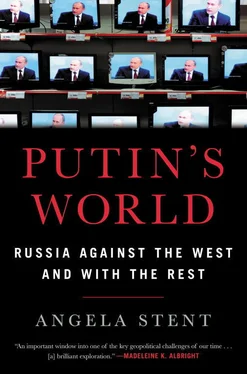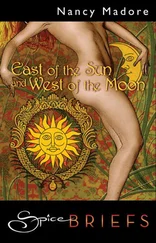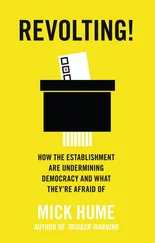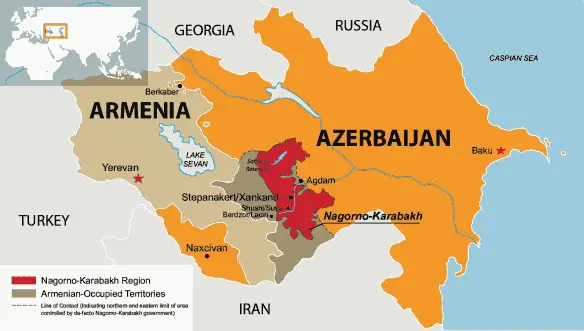
In 1992, armed hostilities between Armenians and Azeris intensified, and eventually a cease-fire was brokered by the OSCE in 1994. The war resulted in 25,000 deaths, and the displacement of 700,000 Azeris and 400,000 Armenians. The Armenians declared their own state in Nagorno-Karabakh and de facto control it, but a peace treaty has never been signed and the Azeri government does not accept that the enclave is no longer part of Azerbaijan. Fighting periodically erupts, and in April 2016 there was a four-day “mini war” that raised fears of renewed conflict. Since 1992, the OSCE has led the Minsk Group, which meets regularly to try to find a solution to the problem; its co-chairs are Russia, the United States, and France. Russia has also periodically sought to bring the Azeri and Armenian sides together to broker a peace agreement but so far has failed. Nagorno-Karabakh represents the essence of the dueling narratives in the post-Soviet space: Armenians base their claim for Nagorno-Karabakh’s independence on the principle of the right to national self-determination. Azeris base their claim to Nagorno-Karabakh on the right to territorial integrity.
Hostilities between the two countries are such that when Turkey reached out to Armenia to normalize relations in 2009 and began to explore the possibility of opening its border with Armenia, Azerbaijan vigorously objected and the Turkish overture was stillborn. 29As a result, only Armenia’s borders to Georgia and Iran are open, which has increased its economic dependence on Russia, although it does not share a border with Russia. Russia continues to supply arms to both Armenia and Azerbaijan. After the annexation of Crimea, Armenia supported Russia in the UN General Assembly, while Azerbaijan voted to condemn the annexation, mindful of what the precedent could mean for Nagorno-Karabakh. Armenia and Azerbaijan remain in a state of war with each other and have no diplomatic relations, but both have extensive ties to Russia.
A careful examination of Russia’s actions shows that, in this frozen conflict, Russia has played a generally constructive role over the past twenty-five years and has coordinated its bilateral efforts with the United States and France. 30Yet it is debatable whether Russia is indeed interested in seeing this conflict end, because the lack of resolution provides it with ongoing leverage over both Armenia and Azerbaijan—which it might lose were the two sides to come to an agreement.
In April 2018, Armenia underwent an unexpected “velvet” popular uprising against the government. Long-term ruler and strongman Serzh Sargsyan was replaced by opposition anti-corruption activist Nikol Pashinyan as prime minister. To the surprise of many, Russia’s reaction was muted. The Russian Foreign Ministry’s Maria Zakharova complimented the Armenian people’s unity in a difficult situation: “Armenia, Russia is always with you!” 31Pashinyan made it clear that Armenia would continue to be allied with Russia and was not seeking to move toward the EU. That is the litmus test for the Kremlin.
Transnistria
Transnistria, the second frozen conflict, is a breakaway region of Moldova that the Russian military and heavy Russian economic subsidies help to sustain. It is a landlocked self-proclaimed state (population 475,000) that lies between the Dniester River and Moldova’s border with Ukraine. Only Nagorno-Karabakh, Abkhazia, and South Ossetia recognize it as a state. It is the only secessionist conflict in the post-Soviet space that remains “frozen” inasmuch as, unlike in Nagorno-Karabakh and Georgia, both sides agree on the boundary line and there is no ongoing fighting. Nevertheless, the war in Ukraine has raised new questions about Russia’s future intentions in this conflict.
As is the case in Ukraine, changing historical borders and complex national identities have facilitated Moscow’s involvement. In the early nineteenth century, Russia took what is present-day Moldova—then called Bessarabia—from the Ottoman Empire. But after the Bolshevik Revolution, most of Bessarabia became part of the Kingdom of Romania. In 1924, the USSR created the Moldovan Autonomous Soviet Socialist Republic out of the territory it still controlled, which is today’s Transnistria. As a result of the Molotov-Ribbentrop Pact, Stalin acquired Bessarabia, and after the end of the war, the USSR regained control over all of today’s Moldova. Moldovans are essentially Romanians, their language and culture are very similar to that of Romania, and the Soviet attempt to create a separate Moldovan ethnic identity only partially succeeded. 32
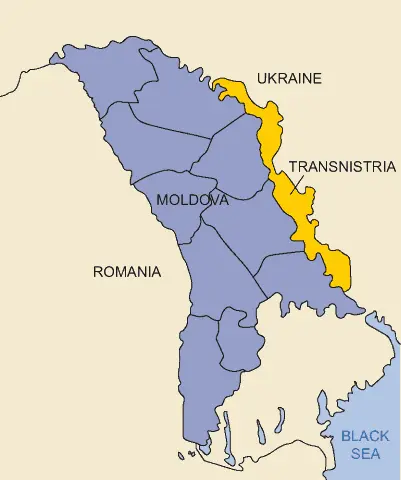
As the USSR unraveled and Moldovans declared their independence, the population of Transnistria objected. Their seven decades under Soviet rule had given them a different identity. They were bound to Russia by strong ties in the military-industrial complex, by the Russian language, and by ties to the Russian 14th Army stationed there. At the time of the Soviet breakup, there was talk of Moldova reuniting with Romania, and the pro-Russian population in Transnistria feared they would be marginalized. They declared their independence from Moldova, and hostilities broke out in 1992 between the new Moldovan armed forces and Russia’s 14th Army. Eventually a cease-fire was signed, and Transnistria emerged as a de facto autonomous state protected by Russian troops, although it is internationally recognized as part of Moldova.
Since the end of hostilities, the OSCE has led a five-plus-two mediation process, consisting of representatives from the OSCE, Russia, Ukraine, the EU, the US, Moldova, and Transnistria, but the group meets only intermittently. Today 75 percent of Moldova’s population of four million is ethnically Romanian, and 6 percent is Russian. In Transnistria, roughly 30 percent is Russian. The area has its own flag, currency, and border guards. It is best known as a haven for smuggling and illicit trafficking of goods and people. But like the other frozen conflicts, it survives not only because of Russian support but also because the authorities in the capital of the region have done quite well from business deals with the separatists. 33
In 2003, the Kremlin decided to intervene actively to resolve the Transnistrian issue by suggesting a plan for federalization of Moldova similar to proposals Putin has put forward more recently for Ukraine. The Kozak Memorandum provided for the settlement of the Transnistrian conflict and the reunification of Moldova with a plan for an asymmetric federation. Some of the most important governmental powers—minority rights, customs, energy, the national bank, law enforcement, federal taxes and budgets, and electoral law—were to be shared equally between the federal government and the two federal subjects: Transnistria and Gagauzia, a region populated by the Russian-speaking Orthodox Turkic Gagauz ethnic group, which had also declared its independence from Moldova. This plan would have given Transnistria a virtual veto over national government policies—including moving closer to the EU and NATO—and would have compromised Moldova’s ability to function as an effective state. It also would have permitted the Russian military to remain in Transnistria. For this reason, the OSCE, the EU, and the United States opposed the memorandum, but Moldovan president Vladimir Voronin was prepared to sign it. Putin announced that he would fly to Chisinau, the capital, to witness the signing. Reporters and television cameras assembled to film the historic moment. But demonstrators gathered in the streets in Chisinau to protest the agreement, and as they were waiting, television screens suddenly went live, broadcasting from Georgia the Rose Revolution, showing President Eduard Shevardnadze being carried out of the parliament to safety as mobs of angry Georgians protested a falsified election. If the president could be overthrown by protestors in Tbilisi, why not in Chisinau?
Читать дальше
